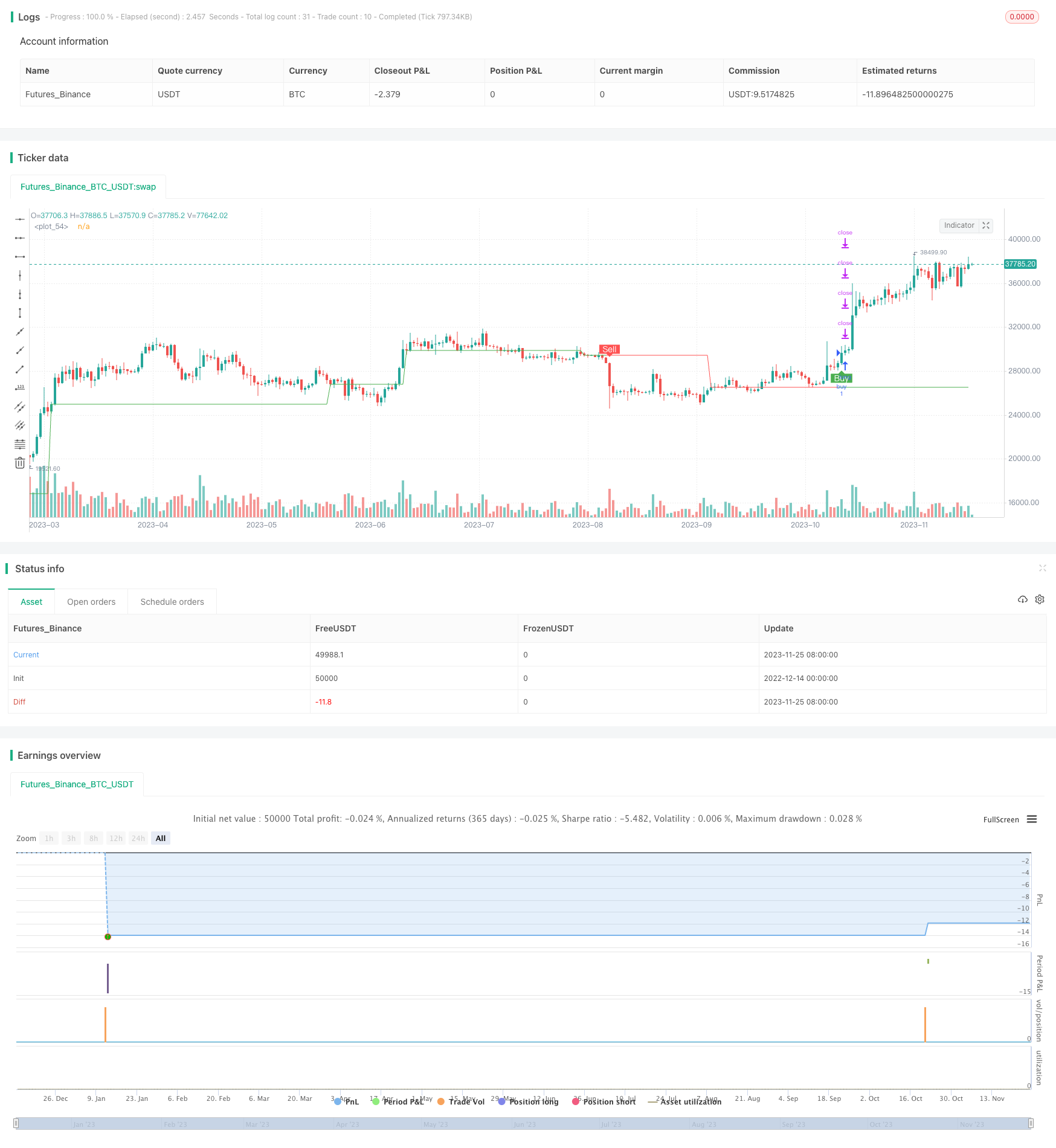Estratégia de negociação quantitativa baseada nos indicadores de tendência TRSI e SUPER

Visão geral
Esta estratégia combina um indicador relativamente forte (TRSI) e um indicador de tendência super (SUPER Trend) para formar um conjunto mais completo de estratégias de negociação quantitativa. A estratégia é usada principalmente para capturar tendências de linha média e longa, enquanto os indicadores de curto prazo são usados para filtrar os sinais de negociação de ruído.
Princípio da estratégia
- Calcular o TRSI para determinar se o mercado está em um estado de sobrecompra ou sobrevenda, emitindo um sinal de compra e venda
- Filtração de sinais de ruído usando o indicador SUPER Trend para confirmar a tendência fundamental
- Configurar um Stop Loss em diferentes fases da tabela de ganhos
Concretamente, a estratégia primeiro calcula o indicador TRSI para determinar se há áreas de sobrevenda no mercado, e depois calcula o indicador SUPER Trend para determinar a direção da grande tendência. A combinação dos dois emite um sinal de negociação.
Análise de vantagens
A estratégia tem as seguintes vantagens:
- Combinação de vários indicadores para melhorar a precisão do sinal.
- Aplica-se a negociação de tendências de linhas médias e longas. Os sinais de supercompra e supervenda são propensos a uma reversão de tendência.
- O Stop Loss Stop Set é razoável, o retorno de lucro em diferentes fases e a retirada de fundos em diferentes proporções, o controle eficaz do risco.
Análise de Riscos
A estratégia também apresenta alguns riscos:
- A situação é muito complicada, e a maioria das pessoas não tem dinheiro para investir, mas não têm dinheiro para investir.
- O parâmetro TRSI está mal configurado, podendo ter perdido um intervalo de super-compra e super-venda.
- Os parâmetros SUPER Trend não estão configurados corretamente e podem emitir sinais errados.
- O espaço de parada é grande demais para controlar o risco de forma eficaz.
Para responder a esses riscos, podemos fazer otimizar as seguintes coisas:
Direção de otimização
- A combinação de mais indicadores de curto prazo para identificar mais oportunidades de negociação.
- Ajustar os parâmetros TRSI para reduzir o intervalo de erro.
- Testar e otimizar os parâmetros da SUPER Trend.
- Configure um stop-loss flutuante e acompanhe o stop-loss em tempo real.
Resumir
Esta estratégia combina vários indicadores, como o TRSI e a SUPER Trend, para formar uma estratégia de negociação quantitativa mais completa. Pode identificar de forma eficaz a tendência de linha média e longa, ao mesmo tempo em que configura o risco de controle de stop loss.
/*backtest
start: 2022-12-14 00:00:00
end: 2023-11-26 05:20:00
period: 1d
basePeriod: 1h
exchanges: [{"eid":"Futures_Binance","currency":"BTC_USDT"}]
*/
//@version=4
strategy(title = "SuperTREX strategy", overlay = true)
strat_dir_input = input(title="Strategy Direction", defval="long", options=["long", "short", "all"])
strat_dir_value = strat_dir_input == "long" ? strategy.direction.long : strat_dir_input == "short" ? strategy.direction.short : strategy.direction.all
strategy.risk.allow_entry_in(strat_dir_value)
length = input( 14 )
overSold = input( 35 )
overBought = input( 70 )
HTF = input("W", type=input.resolution)
ti = change( time(HTF) ) != 0
p = fixnan( ti ? close : na )
vrsi = rsi(p, length)
price = close
var bool long = na
var bool short = na
long :=crossover(vrsi,overSold)
short := crossunder(vrsi,overBought)
var float last_open_long = na
var float last_open_short = na
last_open_long := long ? close : nz(last_open_long[1])
last_open_short := short ? close : nz(last_open_short[1])
entry_value =last_open_long
entry_value1=last_open_short
xy=(entry_value+entry_value)/2
// INPUTS //
st_mult = input(4, title = 'SuperTrend Multiplier', minval = 0, maxval = 100, step = 0.01)
st_period = input(10, title = 'SuperTrend Period', minval = 1)
// CALCULATIONS //
up_lev =xy - (st_mult * atr(st_period))
dn_lev =xy + (st_mult * atr(st_period))
up_trend = 0.0
up_trend := entry_value[1] > up_trend[1] ? max(up_lev, up_trend[1]) : up_lev
down_trend = 0.0
down_trend := entry_value1[1] < down_trend[1] ? min(dn_lev, down_trend[1]) : dn_lev
// Calculate trend var
trend = 0
trend := close > down_trend[1] ? 1: close < up_trend[1] ? -1 : nz(trend[1], 1)
// Calculate SuperTrend Line
st_line = trend ==1 ? up_trend : down_trend
plot(xy,color = trend == 1 ? color.green : color.red)
buy=crossover( close, st_line)
sell1=crossunder(close, st_line)
buy1=buy
//
sell=sell1
// STRATEGY
plotshape(buy , title="buy", text="Buy", color=color.green, style=shape.labelup, location=location.belowbar, size=size.small, textcolor=color.white, transp=0) //plot for buy icon
plotshape(sell, title="sell", text="Sell", color=color.red, style=shape.labeldown, location=location.abovebar, size=size.small, textcolor=color.white, transp=0) //plot for sell icon
// Take profit
//
l = buy
s1=sell
if l
strategy.entry("buy", strategy.long)
if s1
strategy.entry("sell", strategy.short)
per(pcnt) => strategy.position_size != 0 ? round(pcnt / 100 * strategy.position_avg_price / syminfo.mintick) : float(na)
stoploss=input(title=" stop loss", defval=25, minval=0.01)
los = per(stoploss)
q1=input(title=" qty_percent1", defval=25, minval=1)
q2=input(title=" qty_percent2", defval=25, minval=1)
q3=input(title=" qty_percent3", defval=25, minval=1)
tp1=input(title=" Take profit1", defval=2, minval=0.01)
tp2=input(title=" Take profit2", defval=4, minval=0.01)
tp3=input(title=" Take profit3", defval=6, minval=0.01)
tp4=input(title=" Take profit4", defval=8, minval=0.01)
strategy.exit("x1", qty_percent = q1, profit = per(tp1), loss = los)
strategy.exit("x2", qty_percent = q2, profit = per(tp2), loss = los)
strategy.exit("x3", qty_percent = q3, profit = per(tp3), loss = los)
strategy.exit("x4", profit = per(tp4), loss = los)